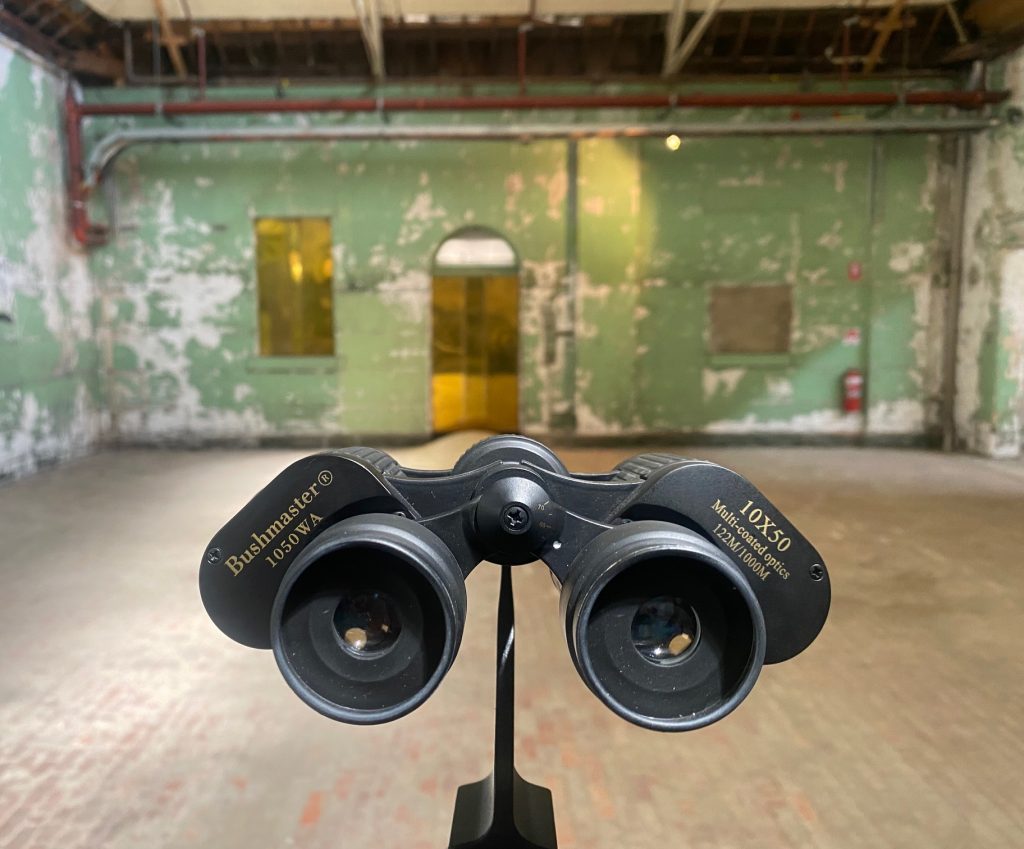According to the promo, When It Rains (I feel like eating Jeon) is an installation inspired by the story of a Korean elder in Ansan, who takes a walk every day to the place where the sea used to be. This work considers the solvent connections between site, sensation and memory, and the routines that we associate with these.”
Sparely set in the Magdalen Laundries of the Abbotsford Convent, the installation features soundscapes in a largely empty space, periodically interrupted by stations that focus attention and toy with the sense of distance and closeness either through gaze, video or miniature installations. Audiences are free to connect with as many or as few elements of the installation as they desire and the minimal explanatory text allows space for individual response. Many of those responses are captured in a small notebook at a station that returns the gaze back into the installation itself with a sweet, reflexive point of engagement.
Collaborating Artists Jihyun Kim, Madeleine Flynn and Tim Humphrey have contextualised their work within a conceptual interplay of space and embodied memory, acknowledging deep respect to the traditional custodians of the land and the Convent’s complex past as a site of institutionalised trauma.
There is much to commend in the work: the desire to connect site and memory; the poignancy of rain and water as metaphors for existential meaning in a climate crisis; and the meditative impact of the spare physical and acoustic landscape.
I visited the work on a busy, sunny Saturday morning, while the precinct played host to a busy farmers market, in a somewhat jarring counterpoint to the installation. I left feeling reflective but wanting more, primarily due to the physical location of the installation itself.
Between 1864 and 1974, more than one thousand women – mostly young, mostly poor and many of them affected by migration, lack of welfare and mental health support, or censured for acting outside of the social mores of the time – toiled in the Magdalen Laundries in unpaid labour for the Catholic nun’s laundry services. The brutal sense of deprivation and the injustice of this particular variety of gendered incarceration continues to reverb in time and made me, at least, question the reason for situating this work in this particular space.
We know from placemaking researchers like Cliff Hague (and countless others) that “places are places (and not just spaces) because they have identity.” The Magdalen Laundries have an expressive and acute identity due to its complex history. Obviously, over time, the space has been used for countless other purposes and there is no strict obligation for this or any other intervention in the space to specifically (or exclusively) address that legacy of history.
But – and this is a meaningful “but” – for a work so purportedly directed towards the enquiry of space and embodied memory, it seemed as if the work and the space were in competition for emotional attention.
Given the multiple concerns of the space, the competition between listening, attunement and curious attention to the interplay of human/environment seemed unfairly positioned against institutional gendered incarceration at scale.
Perhaps the work would have had greater impact in a white cube gallery—for all their illusory and problematic neutrality—who knows? Overall, I left with questions not answers; I craved (for this festival at least) geographical specificity – a sense of why Korean and Australian artists might collectively turn their attention to this particular story of the sea. And, while I enjoyed the acoustic and visual sense of focus generated by the work, I left metaphorically hungry for “Jeon”, looking for the sensorial and bodily engagement cued by the work’s title. The participative elements of the work functioned more like a visitors’ book or comments section than an entry-point for more layered engagement with the installation.
Despite both Korean and Australian (or English language) elements, the work felt oddly culturally ubiquitous (de-racialised and de-culturated) and unmoored from place. In some contexts, this might be appropriately considered a strength of the work: an invitation for expansive associations. This might be a meaningful indication of the more broad-based interest in place, memory and the environmental catalysts for those interactions, but is worth noting given the festival’s expressed intent for connections between contemporary Australia and its growing diaspora.
This work would not be out of place at any number of Australian arts institutions (IMA, ACCA or the like) or contemporary arts festivals. Setting this aside as an appraisal of the work’s intrinsic critical value or interest – but, positioned in the AsiaTOPA festival, When it rains (I feel like eating Jeon) felt like it had further to go in terms of exploring the intercultural impetus for the work in this festival, and was regrettably overpowered by the Magdalen Laundry’s potent history.
Collaborating Artists
Jihyun Kim (South Korea)
Madeleine Flynn and Tim Humphrey (Australia)
Jin Yim Producer (South Korea)
Erin Milne Producer (Australia)

